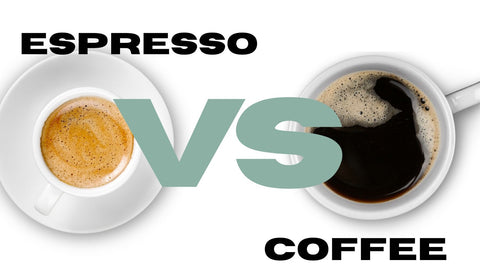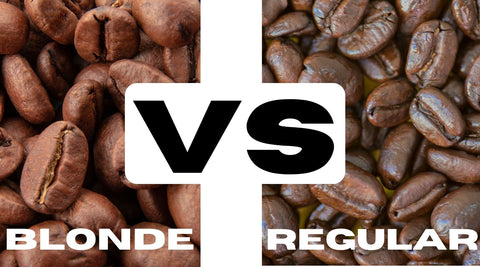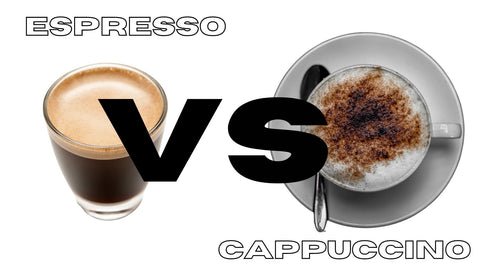Coffee is loved by millions worldwide, and coffee or espresso is a part of daily life for many people. But what do you mean when you ask a friend whether they'd like to go out for coffee? What do you talk about when you say you work on your novel in a cafe while having multiple cups of coffee?
There's a difference between having a cup of coffee, enjoying an espresso shot, or an espresso-based beverage like latte macchiato or cappuccino. But what's that difference, and does it matter?
QUICK ANSWER.......🢃˗ˏˋ☕ˎˊ˗
While both beverages are prepared using coffee grounds, the brewing method differs greatly. There's really only one way to make espresso: by forcing hot water through finely-ground coffee beans with high pressure. On the other hand, coffee can be prepared in various ways and generally isn't as concentrated as an espresso shot. Espresso is fast to make and contains more caffeine per oz than coffee.
Would you like to learn more? Then you’ve come to the right place. In this article, we’ll take a look at everything you need to know to understand the difference between espresso vs coffee. We’ll look at the type of coffee beans, roast levels, brewing methods, and other differences.
But first, here’s a short overview:

Now, let's dive into the details.
Drip Coffee Beans
Drip coffee is the most common method to make coffee, either manually with tools like the V60 or with an automatic filter coffee machine. The process is fairly simple: Hot water is poured over coffee grounds in a filter, and the coffee drips into the cup or jug below the filter. Depending on your method, the process can take up to ten minutes if you're filling a whole jug and about 3-4 minutes for one cup.
It all starts with your choice of coffee beans and how you grind them (or which grind size you buy if you don't have a coffee grinder). For drip coffee, you need medium coffee grounds. Those are the grounds that are about the size of granulated sugar. That's the perfect size for filtered coffee, no matter whether you use cone-shaped filters or filters with a flat bottom.
But what type of beans should you use? That depends only on your taste preferences, as there is a wide variety of coffee beans. First, you'll have to decide between arabica and robusta beans (arabica are more popular, and robusta are stronger but not quite as well-balanced).
You'll then have to choose your coffee beans' origin and roast level. Beans from different countries have different flavor profiles, and your choice depends on you alone. But here are some ideas:
Beans from countries like Guatemala, Costa Rica, and Honduras have a well-balanced acidity, medium body, and a hint of nuttiness or chocolate. They are generally well-suited for coffee.
African beans from countries like Ethiopian and Kenyan beans are known for their bright acidity and fruity, wine-like flavors. They can add a unique and vibrant taste to your brewed coffee.
Blends are also a good choice, as opposed to single-origin coffees. Some coffee roasters have special blends for drip brewing. These blends are designed to achieve a balanced and flavorful cup.
Espresso Beans
Now, the shocking news: Espresso beans are the same as ordinary coffee beans. There's no espresso tree that grows beans that are specifically meant to be brewed as espresso. The beans mentioned above can easily also be used for espresso. However, espresso beans are usually a blend of arabica beans from different origins to create a perfect balance:
-
Italian Roast: A very dark roast that brings out bold and smoky flavors.
-
Espresso Blends: These are specifically labeled for espresso and crafted to deliver a well-rounded and flavorful shot.
-
A blend of Brazilian and Sumatran Beans: These beans are often included in espresso blends for their low acidity and full body.
Can I Use Espresso Beans In My Filter Coffee Maker?
Yes, there’s no reason why you couldn’t, especially if you grind them to a medium grind. As mentioned before, espresso beans are just ordinary coffee beans. They are usually roasted to a darker level, so you’ll get a bold and intense cup of coffee.
Can I Make Espresso From Regular Coffee?
It depends on what you mean. Can you make espresso from the beans you use for regular coffee? Sure thing. Just grind them to a fine grind and use them in your espresso machine. Don't worry if you only have a light roast. Blonde espressos (made with lightly roasted coffee beans) are popular nowadays.
But, if you mean: Can I make an espresso without an espresso machine, then the answer is different. You can make some concentrated coffee drinks similar to espresso without an espresso machine, but it won't be a true espresso. To make an espresso, water must be forced through finely ground beans, usually with a force of 9 bars or more. While this isn't possible with other means, you can get something similar to an espresso by using a Moka pot or an Aeropress instead of espresso machines.
Espresso Vs Coffee: Main Differences
Roast Level
While most espresso beans are roasted to a dark roast (or medium-dark), you can also find light roast espressos these days (usually called blonde espresso). On the other hand, ordinary coffee is usually made with a medium roast, though you can also use light or dark roasts, depending on your preference.
Grind Size
You need a fine grind for espresso shots (like fine sand or fine sugar) because of the short extraction time and the pressure used for making a shot. However, you need a medium or medium-coarse grind for a regular drip coffee, depending on whether you use a manual or automatic coffee maker. Medium is for manual, and medium-coarse is for automatic (as automatic drip makers generally brew faster than an automatic coffee machine).
Brew Method
The brewing method is where the main difference lies. Espresso is a fast and furious brewing method. Hot water is pushed through finely ground coffee under very high pressure in just a few seconds. That gives you that lovely concentrated shot of awesomeness - usually with a lovely layer of crema on top.
On the other hand, brewing coffee via the drip method is a slower process and doesn't require any machinery (but you can get automatic drip machines if you prefer). It's an affordable method to make coffee and very accessible. Water is poured over coffee grounds (in a filter). The grounds and water mingle, and the end product (coffee) drips from the bottom of the filter into a cup or jug.
Brew Time
Espresso:
Typically, the total brew time for a shot of espresso is relatively short, usually around 25 to 30 seconds. The actual extraction time is about 20-30 seconds (when the water is forced through the coffee grounds).
Drip Coffee:
Automatic coffee makers usually need around 5 to 6 minutes to brew a regular coffee pot. A manual pour-over method like Chemex or Hario V60 can take 3-4 minutes for one cup, which includes 30 seconds of blooming.
Crema
Crema is a characteristic of espresso. You usually won't get the lovely golden-brown foam layer on a normal coffee because the foam forms because of the high pressure that's required to make espresso.
While crema looks nice, its presence or absence doesn't influence the taste of your coffee drink!
Caffeine Content
Espresso is stronger and contains more caffeine. While the precise caffeine content varies depending on which type of coffee beans is used, an average shot of espresso contains 65 mg of caffeine (1 shot is usually 1 oz).
An average cup of drip coffee (8 oz) contains about 95 mg of caffeine. Divide 95 mg by 8, and you get roughly 12 mg of caffeine per oz. One shot of espresso contains over five times as much caffeine as one oz of drip coffee.
Conclusion
After reading all of this, you know that you talk about espresso-based drinks when you invite a friend to have a coffee in a cafe (unless you're one of the people who orders ordinary brewed coffee in Starbucks). Of course, you can also use ordinary coffee to make some interesting coffee drinks, but usually, you need an espresso base for drinks like cappuccino, flat white, and latte macchiato.
Espresso Vs Coffee FAQ
How Much Espresso Is Equal To A Cup Of Regular Coffee?
If you want to know how many espressos you have to drink to get the same amount of caffeine as you’d get from a regular cup of coffee, you need to do some math (oh dear). This is the answer:
To get the number of espresso shots needed, you need to divide the caffeine content in a cup of regular coffee by the caffeine content in 1 ounce of espresso. If we use the average numbers from above, we have to divide 95 by 65. That would mean the answer is 1.46. So, rounded up, you need to drink one and a half shots of espresso to get the same amount of caffeine.
Which Is Easier On The Stomach: Espresso Or Coffee?
Espresso is generally less acidic than coffee because of the shorter brewing time and higher pressure. Some people feel that the lower acidity is gentler on the stomach. Coffee has more acidity, but you can choose lower-acidity beans to reduce stomach issues (if you have a sensitive stomach). Beans from certain countries, like Brazil, are known to have a lower acidity.
Choosing a darker roast can also help to reduce acidity. If you have an issue with caffeine sensitivity, you can opt for caffeine-reduced or caffeine-free versions of espresso and drip coffee (decaffeinated).



